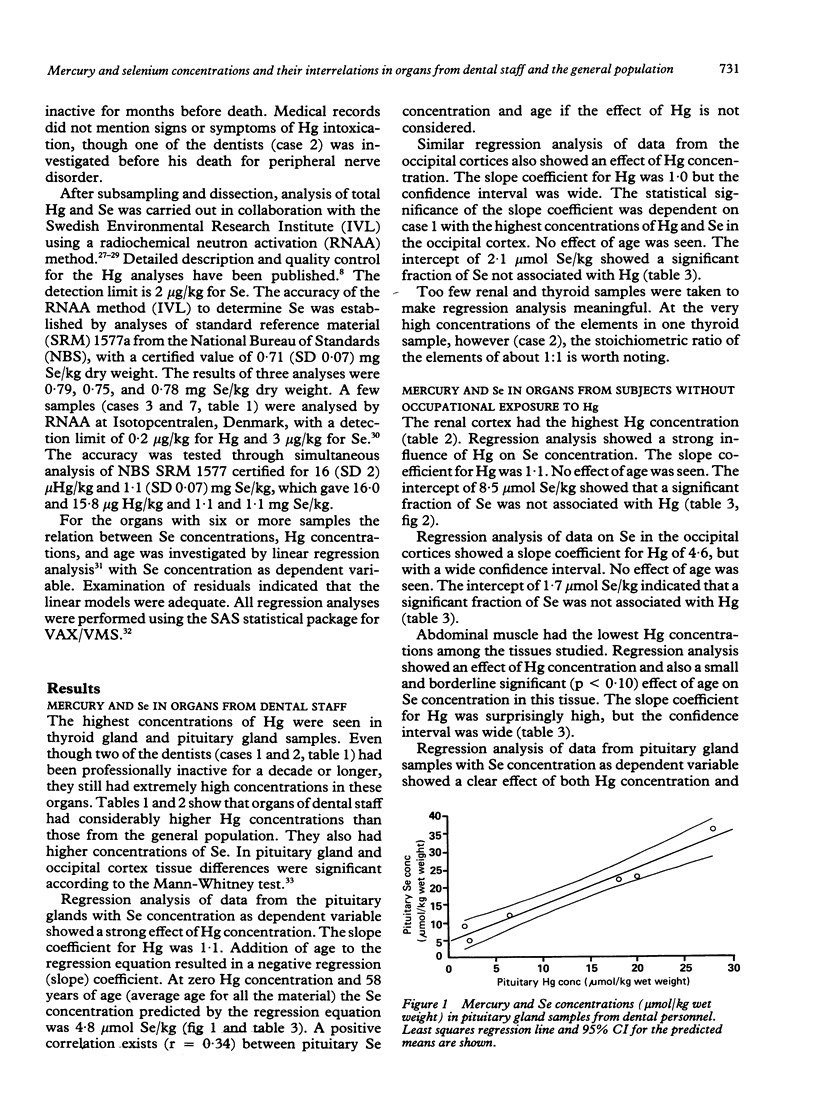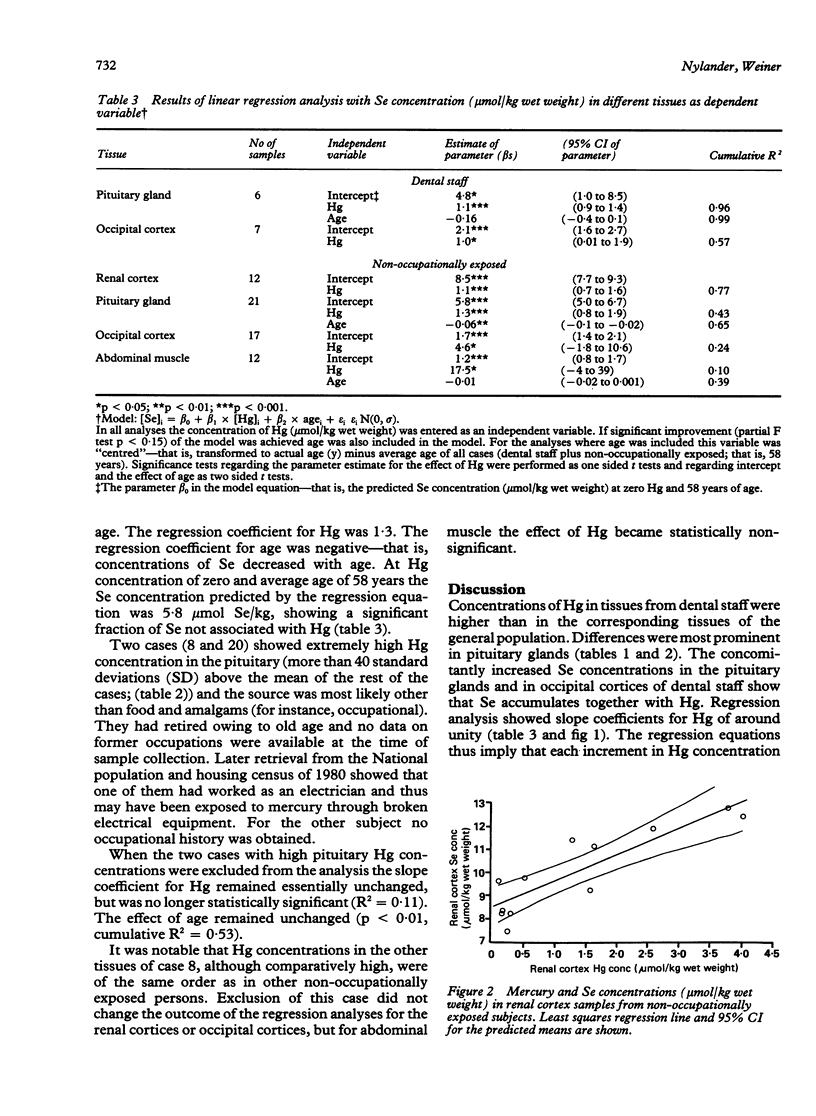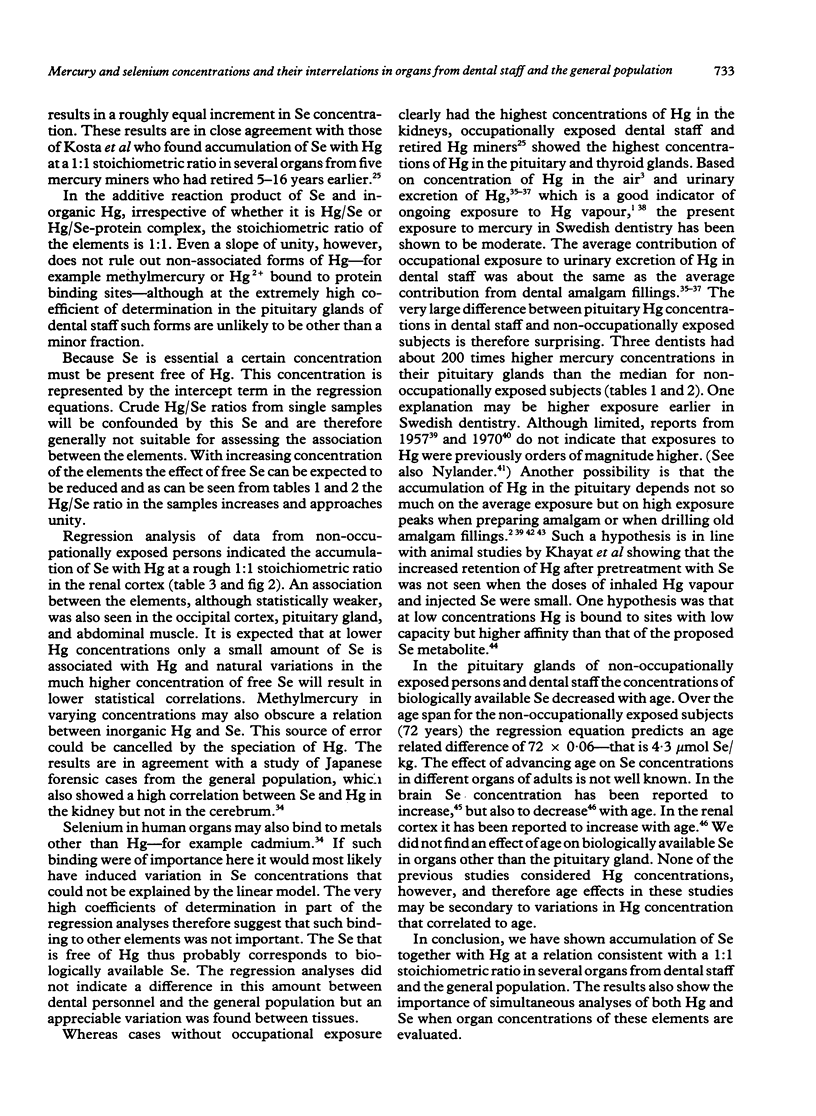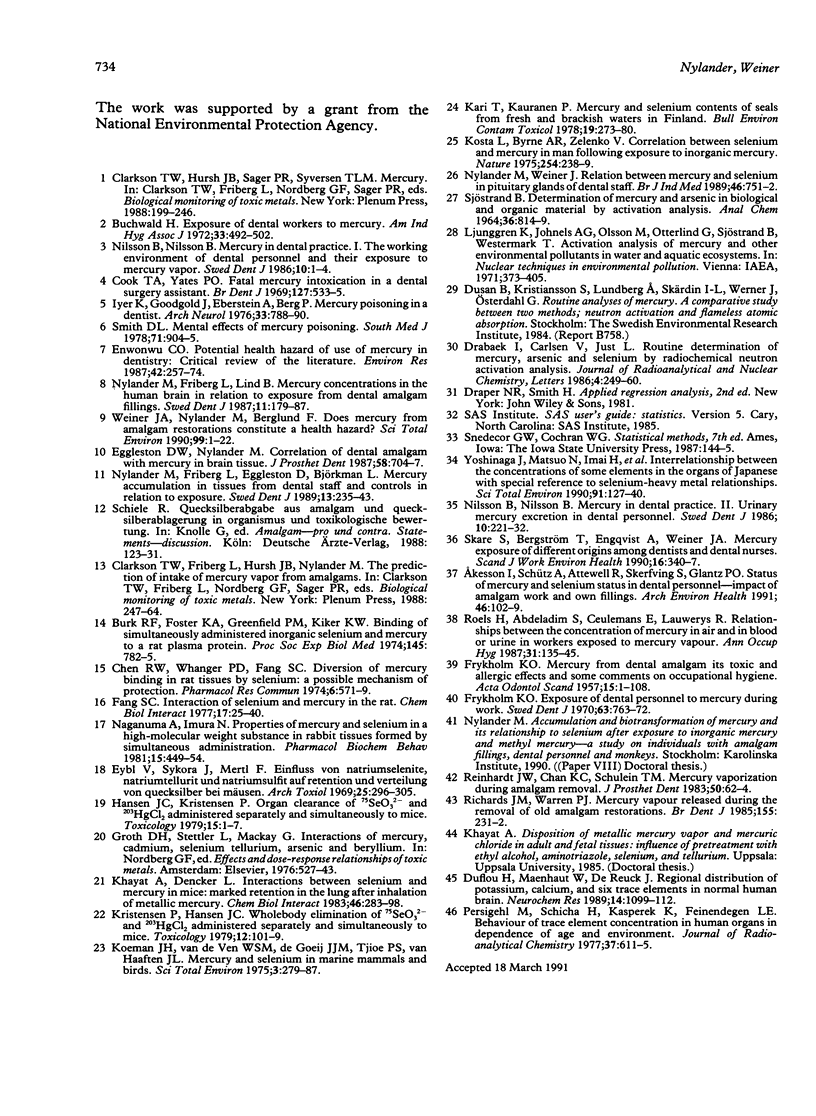Abstract
Mercury (Hg) and selenium (Se) concentrations were determined by radiochemical neutron activation analysis in samples from the pituitary glands, occipital cortices, renal cortices, abdominal muscles, and thyroid glands of cadavers. Samples were retrieved from dental staff occupationally exposed to Hg and from the general population. Increased concentrations of both Hg and Se in samples from dental staff showed that Se accumulated together with Hg. Regression analysis of data from the pituitary glands and occipital cortices of dental staff indicated the accumulation of Se at a rough stoichiometric ratio of 1:1 with Hg. The same stoichiometric ratio between the elements was seen in the renal cortices from the general population. The regression analysis showed that a substantial fraction of Se was not associated with Hg; it is assumed that this corresponds to biologically available Se. Concentrations of biologically available Se decreased with advancing age in the pituitary gland, but not in other organs, and varied appreciably between organs.
Full text
PDF





Selected References
These references are in PubMed. This may not be the complete list of references from this article.
- Akesson I., Schutz A., Attewell R., Skerfving S., Glantz P. O. Status of mercury and selenium in dental personnel: impact of amalgam work and own fillings. Arch Environ Health. 1991 Mar-Apr;46(2):102–109. doi: 10.1080/00039896.1991.9937436. [DOI] [PubMed] [Google Scholar]
- Buchwald H. Exposure of dental workers to mercury. Am Ind Hyg Assoc J. 1972 Jul;33(7):492–502. doi: 10.1080/0002889728506692. [DOI] [PubMed] [Google Scholar]
- Burk R. F., Foster K. A., Greenfield P. M., Kiker K. W., Hannon J. P. Binding of simultaneously administered inorganic selenium and mercury to a rat plasma protein. Proc Soc Exp Biol Med. 1974 Mar;145(3):782–785. doi: 10.3181/00379727-145-37894. [DOI] [PubMed] [Google Scholar]
- Chen R. W., Whanger P. D., Fang S. C. Diversion of mercury binding in rat tissues by selenium: a possible mechanism of protection. Pharmacol Res Commun. 1974 Dec;6(6):571–579. doi: 10.1016/s0031-6989(74)80006-8. [DOI] [PubMed] [Google Scholar]
- Duflou H., Maenhaut W., De Reuck J. Regional distribution of potassium, calcium, and six trace elements in normal human brain. Neurochem Res. 1989 Nov;14(11):1099–1112. doi: 10.1007/BF00965616. [DOI] [PubMed] [Google Scholar]
- Eggleston D. W., Nylander M. Correlation of dental amalgam with mercury in brain tissue. J Prosthet Dent. 1987 Dec;58(6):704–707. doi: 10.1016/0022-3913(87)90424-0. [DOI] [PubMed] [Google Scholar]
- Enwonwu C. O. Potential health hazard of use of mercury in dentistry: critical review of the literature. Environ Res. 1987 Feb;42(1):257–274. doi: 10.1016/s0013-9351(87)80027-0. [DOI] [PubMed] [Google Scholar]
- Eybl V., Sýkora J., Mertl F. Einfluss von Natriumselenit, Natriumtellurit und Natriumsulfit auf Retention und Verteilung von Quecksilber bei Mäusen. Arch Toxikol. 1969;24(3):296–305. [PubMed] [Google Scholar]
- Fang S. C. Interaction of selenium and mercury in the rat. Chem Biol Interact. 1977 Apr;17(1):25–40. doi: 10.1016/0009-2797(77)90069-2. [DOI] [PubMed] [Google Scholar]
- Frykholm K. O. Exposure of dental personnel to mercury during work. A comparative study using advanced analytical methods. Sven Tandlak Tidskr. 1970 Nov;63(11):763–772. [PubMed] [Google Scholar]
- Hansen J. C., Kristensen P. Organ clearance of 75SeO3(2-) and 203HgCl2 administered separately and simultaneously to mice. Toxicology. 1979 Dec;15(1):1–17. doi: 10.1016/0300-483x(79)90015-5. [DOI] [PubMed] [Google Scholar]
- Iyer K., Goodgold J., Eberstein A., Berg P. Mercury poisoning in a dentist. Arch Neurol. 1976 Nov;33(11):788–790. doi: 10.1001/archneur.1976.00500110056011. [DOI] [PubMed] [Google Scholar]
- Kari T., Kauranen P. Mercury and selenium contents of seals from fresh and brackish waters in Finland. Bull Environ Contam Toxicol. 1978 Mar;19(3):273–280. doi: 10.1007/BF01685798. [DOI] [PubMed] [Google Scholar]
- Khayat A., Dencker L. Interactions between selenium and mercury in mice: marked retention in the lung after inhalation of metallic mercury. Chem Biol Interact. 1983 Sep 15;46(3):283–298. doi: 10.1016/0009-2797(83)90014-5. [DOI] [PubMed] [Google Scholar]
- Koeman J. H., van de Ven W. S., de Goeij J. J., Tjioe P. S., van Haaften J. L. Mercury and selenium in marine mammals and birds. Sci Total Environ. 1975 Jan;3(3):279–287. doi: 10.1016/0048-9697(75)90052-2. [DOI] [PubMed] [Google Scholar]
- Kosta L., Byrne A. R., Zelenko V. Correlation between selenium and mercury in man following exposure to inorganic mercury. Nature. 1975 Mar 20;254(5497):238–239. doi: 10.1038/254238a0. [DOI] [PubMed] [Google Scholar]
- Kristensen P., Hansen J. C. Wholebody elimination of 75SeO2-3 and 203HgCl2 administered separately and simultaneously to mice. Toxicology. 1979 Feb;12(2):101–109. doi: 10.1016/0300-483x(79)90036-2. [DOI] [PubMed] [Google Scholar]
- Naganuma A., Imura N. Properties of mercury and selenium in a high-molecular weight substance in rabbit tissues formed by simultaneous administration. Pharmacol Biochem Behav. 1981 Sep;15(3):449–454. doi: 10.1016/0091-3057(81)90276-8. [DOI] [PubMed] [Google Scholar]
- Nilsson B., Nilsson B. Mercury in dental practice. I. The working environment of dental personnel and their exposure to mercury vapor. Swed Dent J. 1986;10(1-2):1–14. [PubMed] [Google Scholar]
- Nilsson B., Nilsson B. Mercury in dental practice. II. Urinary mercury excretion in dental personnel. Swed Dent J. 1986;10(6):221–232. [PubMed] [Google Scholar]
- Nylander M., Friberg L., Eggleston D., Björkman L. Mercury accumulation in tissues from dental staff and controls in relation to exposure. Swed Dent J. 1989;13(6):235–243. [PubMed] [Google Scholar]
- Nylander M., Friberg L., Lind B. Mercury concentrations in the human brain and kidneys in relation to exposure from dental amalgam fillings. Swed Dent J. 1987;11(5):179–187. [PubMed] [Google Scholar]
- Nylander M., Weiner J. Relation between mercury and selenium in pituitary glands of dental staff. Br J Ind Med. 1989 Oct;46(10):751–752. doi: 10.1136/oem.46.10.751. [DOI] [PMC free article] [PubMed] [Google Scholar]
- Reinhardt J. W., Chan K. C., Schulein T. M. Mercury vaporization during amalgam removal. J Prosthet Dent. 1983 Jul;50(1):62–64. doi: 10.1016/0022-3913(83)90167-1. [DOI] [PubMed] [Google Scholar]
- Richards J. M., Warren P. J. Mercury vapour released during the removal of old amalgam restorations. Br Dent J. 1985 Oct 5;159(7):231–232. doi: 10.1038/sj.bdj.4805688. [DOI] [PubMed] [Google Scholar]
- Roels H., Abdeladim S., Ceulemans E., Lauwerys R. Relationships between the concentrations of mercury in air and in blood or urine in workers exposed to mercury vapour. Ann Occup Hyg. 1987;31(2):135–145. doi: 10.1093/annhyg/31.2.135. [DOI] [PubMed] [Google Scholar]
- Skare I., Bergström T., Engqvist A., Weiner J. A. Mercury exposure of different origins among dentists and dental nurses. Scand J Work Environ Health. 1990 Oct;16(5):340–347. doi: 10.5271/sjweh.1774. [DOI] [PubMed] [Google Scholar]
- Smith D. L., Jr Mental effects of mercury poisoning. South Med J. 1978 Aug;71(8):904–905. doi: 10.1097/00007611-197808000-00009. [DOI] [PubMed] [Google Scholar]
- Weiner J. A., Nylander M., Berglund F. Does mercury from amalgam restorations constitute a health hazard? Sci Total Environ. 1990 Dec 1;99(1-2):1–22. doi: 10.1016/0048-9697(90)90206-a. [DOI] [PubMed] [Google Scholar]
- Yoshinaga J., Matsuo N., Imai H., Nakazawa M., Suzuki T., Morita M., Akagi H. Interrelationship between the concentrations of some elements in the organs of Japanese with special reference to selenium-heavy metal relationships. Sci Total Environ. 1990 Feb;91:127–140. doi: 10.1016/0048-9697(90)90294-5. [DOI] [PubMed] [Google Scholar]


